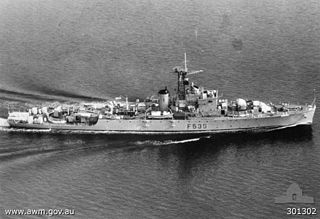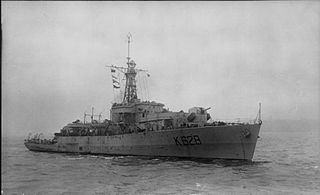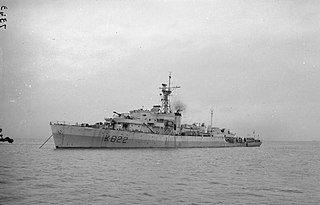
HMAS Shoalhaven (K535/M535/F535), named for the Shoalhaven River in New South Wales, was a modified River-class frigate of the Royal Australian Navy. She was laid down by Walkers at Maryborough on 18 December 1943, launched on 14 December 1944 by Senator Dorothy Tangney and commissioned at Urangan Pier in Hervey Bay in Queensland on 2 May 1946. Her first commander was Commander Rodney Rhoades.

HMS Loch Fada was the lead ship of the Loch-class frigates of the British Royal Navy, built by John Brown & Company of Clydebank, Scotland, and named after Loch Fada in the Inner Hebrides.

HMS Loch Killisport (K628/F628) was a Loch-class frigate of the British Royal Navy, named after Loch Killisport in Scotland. Launched in 1944, the ship was not commissioned until July 1945, and served in post-war repatriation operations in the Far East until decommissioned in April 1946. During this time Prince Philip was an officer on board this ship. Recommissioned in 1950 she served in the Home Fleet for two years, before being extensively modernised for service in the Persian Gulf and Far East. Decommissioned in August 1965, she was sold for scrapping in 1970.

USS Stickell (DD-888) was a Gearing-class destroyer of the United States Navy in service from 1945 to 1972. She was renamed HS Kanaris (D212) in 1972 on transfer to the Hellenic Navy.

USS Albert David (FF-1050) was a Garcia-class destroyer escort, later reclassified as a frigate, in the United States Navy. She was named for Lieutenant Albert David, a Medal of Honor recipient. His was the only Medal of Honor awarded to a member of the Navy in the Atlantic Theater of Operations in World War II. Laid down on 28 April 1964 and commissioned on 19 October 1968, Albert David served in the Pacific, including performing gunfire support operations in Vietnam during the 1970s. She was briefly deployed to the Arabian Sea in September and October 1982. On 18 September 1989 she was leased to the Brazilian Navy, and then sold to Brazil where she served as the destroyer Pará until 12 November 2008 when she was decommissioned and put in reserve. She appears to have been scrapped as of 2015.

USS Bausell (DD-845) was a Gearing-class destroyer in the United States Navy during the Korean War and the Vietnam War. She was named for Marine Corporal Lewis K. Bausell (1924–1944), who was awarded the Medal of Honor posthumously for "conspicuous gallantry" during the Battle of Peleliu.

The fourth USS Worden (DLG/CG-18), a Leahy-class cruiser, was a ship of the United States Navy named in honor of Admiral John L. Worden. Originally called a "destroyer leader" or frigate, in 1975 she was redesignated a cruiser in the Navy's ship reclassification. The ship entered service in 1963 and participated in the Vietnam War.

HMS Bigbury Bay was a Bay-class anti-aircraft frigate of the British Royal Navy, named for Bigbury Bay in Devon.

HMS Burghead Bay was a Bay-class anti-aircraft frigate of the British Royal Navy, named for Burghead Bay in Morayshire.

HMS Cardigan Bay was a Bay-class anti-aircraft frigate of the British Royal Navy, named after Cardigan Bay, off the coast of Ceredigion, Wales.
HMS St Austell Bay was a Bay-class anti-aircraft frigate of the British Royal Navy, named after St Austell Bay on the south coast of Cornwall. In commission from 1945 until 1956, she served in the Mediterranean Fleet and on the America and West Indies Squadron.
HMS St Brides Bay was a Bay-class anti-aircraft frigate of the British Royal Navy, named for St Brides Bay in Pembrokeshire. In commission from 1945 to 1961, she served in the Mediterranean and Eastern Fleets, seeing active service in the Korean War.

HMS Veryan Bay was a Bay-class anti-aircraft frigate of the British Royal Navy, named after Veryan Bay on the south coast of Cornwall. In commission from 1945 until 1957, she saw service in the Pacific, Mediterranean, and Home Fleets, in the West Indies and in the South Atlantic.

HMS Whitesand Bay was a Bay-class anti-aircraft frigate of the British Royal Navy, named for Whitesand Bay in Cornwall. In commission from 1945 to 1954, she served in the Pacific, Mediterranean, West Indies and Far East Fleets, seeing active service in the Korean War.

HMS Loch Fyne was a Loch-class frigate of the British Royal Navy, built by the Burntisland Shipbuilding Company Ltd, Burntisland, Fife, Scotland, and named after Loch Fyne in Scotland. The ship was launched in 1944, and served at the end of World War II. Recommissioned in 1951, she served in the Persian Gulf and was scrapped in 1970.

USS Albatross (MSC-289) was the lead ship of the Albatross-class coastal minesweeper acquired by the U.S. Navy for clearing coastal minefields.

HMNZS Rotoiti (F625) was a Loch-class frigate of the Royal New Zealand Navy (RNZN), which had formerly served in the British Royal Navy as HMS Loch Katrine at the end of World War II.

HMNZS Hawea (F422), formerly HMS Loch Eck (K422), was one of six Loch-class frigates that served in both the Royal Navy (RN) and the Royal New Zealand Navy (RNZN). The ship was laid down by Smiths Dock on 25 October 1943, launched on 25 April 1944 and commissioned into the Royal Navy as HMS Loch Eck on 7 November 1944.

HMS Loch Achray was a Loch-class frigate of the Royal Navy. She was built by Smith's Dock Co. Ltd. in South Bank-on-Tees and launched on 7 July 1944. After service in World War II, she was sold to the Royal New Zealand Navy and renamed HMNZS Kaniere (F426) in September 1948. After service in the Korean War, she was used as a training ship from 1957. She was sold in 1966 for breaking up in Hong Kong.

HMS Loch Achanalt was a Loch-class frigate of the Royal Navy that was loaned to and served with the Royal Canadian Navy during World War II. Ordered from Henry Robb, Leith, on 24 July 1942 as a River-class frigate, the order was changed, and ship laid down on 14 September 1943, and launched by Mrs. A.V. Alexander, wife of the First Lord of the Admiralty on 23 March 1944 and completed on 11 August 1944. After the war she was transferred to the Royal New Zealand Navy and renamed Pukaki.


















